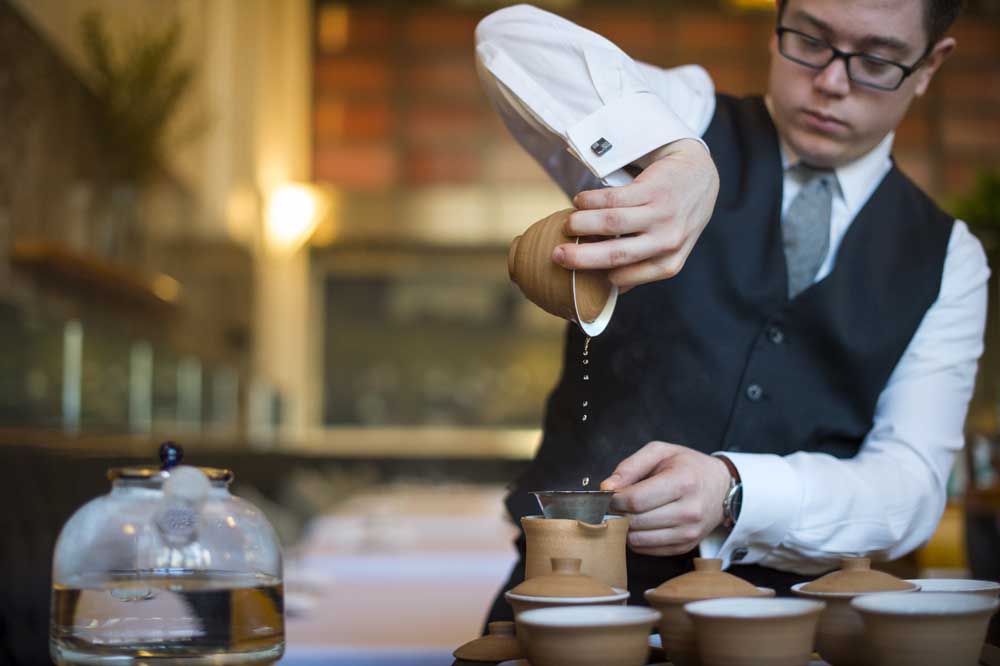Tea culture is blossoming in the U.S.
Published 12:00 am Sunday, May 10, 2015

- Joshua Bright / New York Times News ServiceTodd Chatterton, an assistant server at Eleven Madison Park, prepares a second steeping of High Mountain Oolong during tableside tea service at the New York restaurant.
NEW YORK — For decades, to be a tea lover in the United States was to wander in a wasteland. Even as Americans discovered fine coffee, with specialty coffee shops springing up across the country and debates over the merits of pour-over and cold brew, tea remained a largely pedestrian choice among mass-produced brands.
“When I was growing up, tea was drunk by old people and sick people,” said Dr. Andrew Weil, 72, director of the Arizona Center for Integrative Medicine. “It was Lipton and it was terrible.”
No longer. Online tea purveyors and tea salons offer a dazzling range of loose leaf teas from around the world, sponsor tea preparation classes and sell artisan teaware. Chain-store tea salons are appearing across the country, too: In 2012, Starbucks bought Teavana, which has 301 stores in the United States.
The Tea Association of the USA reported that retail sales of tea have soared from just under $2 billion in 1990 to nearly $11 billion last year, and a broad array of brands and styles can be found on supermarket shelves.
In New York, high-end restaurants such as Eleven Madison Park, Atera, Blanca and Betony have extensive tea lists, often with tasting notes to match. Matcha in particular is in vogue; the frothy powdered Japanese green tea is featured at shops such as MatchaBar in Williamsburg, Brooklyn.
Tea’s partisans cherish its complexity of flavors; the calming, often meditative, nature of tea drinking; and the subtleties of tea growing, processing and aging.
Many can remember the moment they realized drinking tea could go beyond black tea bags.
Weil was 17 when he visited Japan in 1959 and discovered sencha and matcha. For Christopher Day, who runs the tea program at Eleven Madison Park, the epiphany was a sip of rose tea in a Chinese apothecary on a back street in Philadelphia. And for Sebastian Beckwith, a tea importer, it came while shepherding tourists around the tea plantations of Bhutan and Sikkim when he served as an adventure travel guide.
Beckwith, an engaging, unpretentious and encyclopedic tea maven, presides over tea tastings in a spare, serene apartment and office in the Flatiron district. On one wall is an oak pharmacy chest with dozens of small drawers containing tea samples. On the other, a glass container of water supplies his bubbling teapot.
One recent morning, he set out the elements of a Chinese style of tea service known as gong fu cha: a slatted wooden tea tray to catch excess water and tea, a lidded dish called a gaiwan for steeping, a pitcher to hold the steeped tea, and a few small porcelain teacups. As he deftly poured, steeped, discarded and resteeped, he provided a guided tour of tea, describing how it is grown, picked, processed and tasted.
Beckwith set out an oolong, a partly oxidized tea prized by enthusiasts for its complexity of flavors. Picking up the steeped leaves, he pointed to bite marks. They are made, he explained, by a small green insect called a leafhopper. The bites expose that part of the leaf to air, changing its chemistry and giving the resulting tea a distinctive sweetness that has traces of honey.
At Eleven Madison, Day has adapted the same gong fu style of tea serving to the more formal and less leisurely demands of a restaurant. Its offers change with the season, with 32 types of tea served by the pot and five different teas available for tableside tastings for two people priced from $26 to $65.
Day began one of the earliest restaurant tea programs in New York City in 2002, while working at RM, with the chef Rick Moonen, and started the tea service nearly five years ago at Eleven Madison, where he is the dining room manager. “Why is it that we as restaurant professionals spend so much time making sure every aspect of a meal is perfect and then at the end serve tea bags in a wooden box?” he said.
He has created the opposite experience with his tableside tastings, where a waiter wheels out a cart with the same basic equipment as Beckwith’s to present and prepare the teas. This spring, the restaurant offers three oolongs , a black tea and a 2003 aged pu-erh.
But there are as many settings to enjoy great tea in New York as there are tea varieties. Far from the soaring ceilings of Eleven Madison Park, a modest storefront on Flushing’s Main Street houses Fang Gourmet Tea, long a gathering spot for Chinese tea aficionados.
Fang, run by a Taiwanese family whose expertise spans generations, offers tastes of more than 70 teas at $5 to $10 for several steepings, and stocks dozens more. Pierra Cheung, gentle and authoritative, pours tea from a gaiwan in a room decorated with Chinese paintings and glass cases of prized teaware that can run hundreds of dollars (or, in some cases, thousands).






